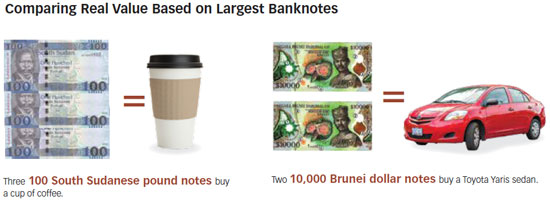Striking the Right Note: a History of Paper Money

WASHINGTON DC, Aug 29 (IPS) - TADEUSZ GALEZA is a research officer in the IMF's Monetary and Capital Markets Department. JAMES CHAN is a senior information management assistant in the IMF's Statistics Department.From strings of shells in the Solomon Islands to large stone disks on the Micronesian isle of Yap or wheels of Parmigiano-Reggiano cheese in Italy, money has taken many forms throughout history.

To see this diversity in action, we need look no further than the 189 member countries of the IMF that churn out 136 unique national currencies and form four currency unions.
Standouts include the Malawian kwacha, the smallest banknote in our study at about 87 percent the size of the US dollar bill. At the other end of the spectrum are the Brunei and the Singapore dollars, the largest banknotes in circulation, each with a total area of more than 150 percent of the US dollar bill—calling for a really deep wallet.
Banknotes across the world are rectangular, but most are wider rather than they are tall. Swiss francs, for example, tend to be very slender, while British pounds and Kenyan shillings are more square.
Yet despite the variations in design, the properties that define currency are the same: they are a unit of measure, a store of value, and a medium of exchange. Paper bills, or "fiat" money, also have no intrinsic value; their worth is determined solely through supply and demand, and they are declared legal tender by government decree.
The most important element that separates one national currency from another is its value. Central banks decide what the largest note in circulation should be, and its nominal value is determined by the number of zeros—this indicates the purchasing power of the note within the country.
Currently, the largest bills changing hands range from 20 Bahrain dinars to 500,000 Vietnamese dong. Historically, because of hyperinflation, many countries printed banknotes with a cartoonish number of zeros: Yugoslavia issued a 500 billion dinar bill in 1991, and Zimbabwe a 100 trillion dollar bill in 2009.

Today, a hundred units of currency (for example, 100 US dollars) is most commonly the highest available banknote in each country. But the real value (proxied here by its worth in US dollars) is where the rubber hits the road.
On average, the largest banknote in circulation across countries is equivalent to 33 US dollars, but the difference in real value from country to country could not be more stark. It takes three 100 South Sudanese pound notes (their largest in circulation) to purchase a medium coffee at Starbucks. At the opposite end, it takes only two of Brunei's largest bills—10,000 dollar notes—to buy a 2018 Toyota Yaris sedan.

With digital currencies and online transactions gaining steam worldwide, the future of paper money may be in jeopardy. What was once valued precisely because of its physicality is giving way to a new global economy where more and more transactions—big and small—are processed electronically.
Perhaps one day countries will design and issue banknotes of the virtual kind, embedded with even richer features to celebrate all they hold dear. Until then, however, paper banknotes will retain an undeniable appeal.
The link to the original article follows: http://www.imf.org/external/pubs/ft/fandd/2018/06/value-of-paper-money-around-the-world/currency.htm?utm_medium=email&utm_source=govdelivery
PHOTO CREDITS: ISTOCK.COM/BENEDEK, MICHAEL BURRELL, YEVGENROMANENKO, ALAMY.COM/CHRISTOPH RUEEGG, CHRONICLE
Opinions expressed in the article are those of the authors; they do not necessarily reflect IMF policy.
© Inter Press Service (2018) — All Rights Reserved. Original source: Inter Press Service
 Global Issues
Global Issues